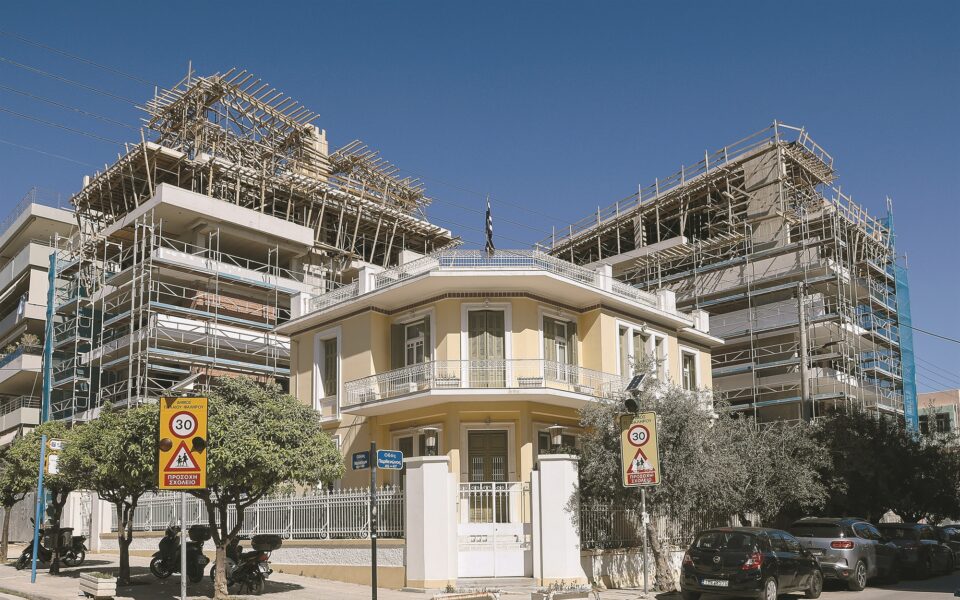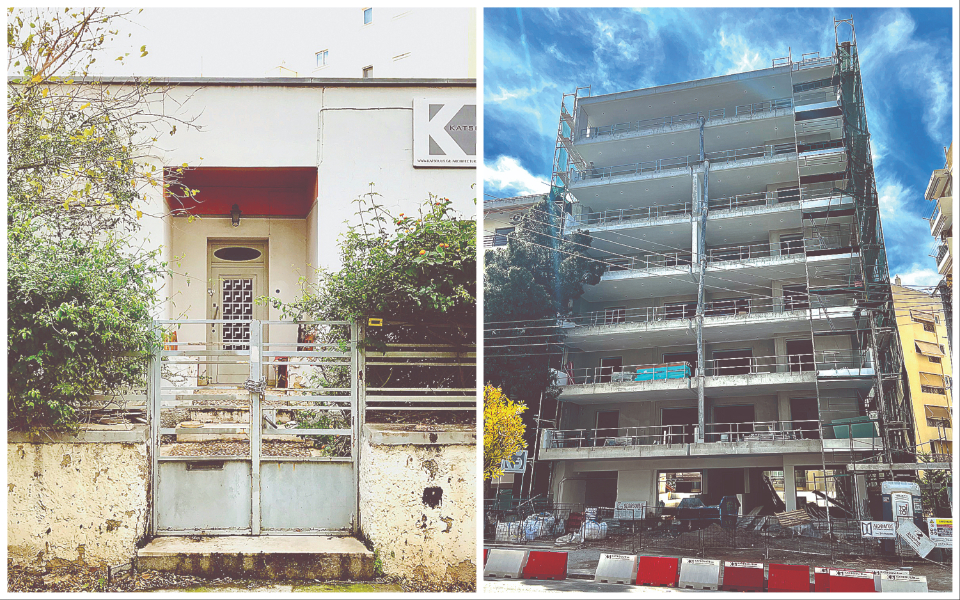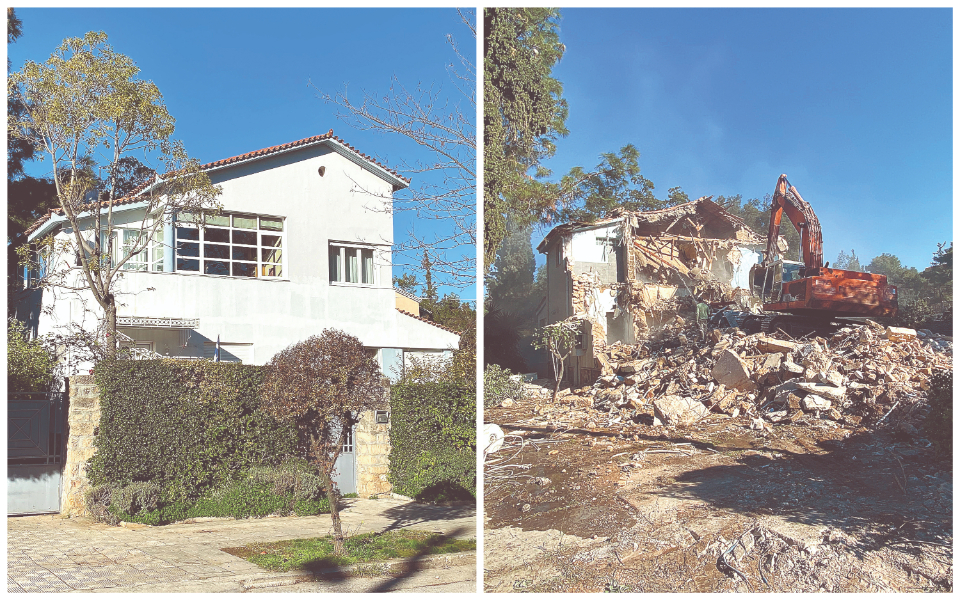The third large die-off of Athens houses
Last single-family dwellings disappearing in latest wave of apartment block construction

“What can I say, son? It looks like people just hate the soil,” says Mrs Ourania as she sweeps the yard at what is one of the last surviving detached houses in the Athens suburb of Nea Smyrni. I ask how she feels about the transformation of her tiny street, which has seen apartment blocks replace the older houses – most pre-war – with increasing rapidity in the past couple of years, and she says it reminds her of the 1990s. “We lost hundreds of houses with small gardens and yards; it was madness,” she says of the big construction boom of that era.
Nea Smyrni, like fellow suburbs Dafni, Elliniko, Alimos, Voula and Glyfada, but also Halandri, Psychiko and Papagou further north, are right on the front line of what may be called the third wave of Athens’ suburban expansion.
The first big urbanization boom took place in the 1970s – when thousands of houses and their plots were signed over to developers in exchange for an apartment or a few apartments in the new block, a system known as “antiparochi.” The proliferation of mixed-use apartment blocks from that boom also cemented the Attica basin’s urban identity.
The last wave before the present one was during the economic boom of 1995-2005 and it was even more prolific than the present one. Cheap loans, the stock market bubble, buoyant sentiment from the prospect of the 2004 Olympic Games and other factors drove the acceleration of construction activity. That wave not only washed away hundreds more houses in the space of a few years, it replaced them with even taller apartment blocks of seven or eight stories, having a profound impact on the microclimate of the city’s mostly narrow streets by blocking the natural sunlight and air circulation, as well as razing what greenery there was along sidewalks to make way for parking garages for the city’s burgeoning fleet of cars.

“Nea Smyrni’s greatest downfall was the destruction of its front gardens, which had been mandatory when the neighborhood was first built as a ‘green suburb’ before World War II. These have been replaced by shallow, unhealthy patches of greenery that allowed the construction of parking garages,” says civil engineer and local resident Angelos Papaioannou.
“It’s a tsunami,” says Irini Gratsia, an archaeologist and coordinator at Monumenta, a nongovernmental organization dedicated to recording the country’s 19th and 20th century building stock and spearheading efforts to save it.
“I think we’re experiencing a repeat of the 1970s – and that is no exaggeration. We can’t keep up at Monumenta with the emails and messages coming in every day about buildings being demolished in many parts of Athens, but also in other cities like Thessaloniki and Alexandroupoli. Most concern buildings from the 1920s and 30s, but there are also post-war ones from the 50s, the 60s and even the 70s. This wave of demolitions increased in 2022 and continues unabated in 2023,” she says.
What we’re actually seeing is the coiled-spring stemming from a decade of economic crisis and the significant contraction of construction activity. Most of the licenses for buildings constructed from 2018 onward were issued during the difficult years of the recession as a result of a surge in sales of land and property – on very favorable terms for the buyers.
Never-ending antiparochi
Most of the houses being demolished are not architecturally noteworthy, which is why they have never been listed for preservation by the ministries of Environment or Culture. This is their undoing. While they may not have the aesthetic caliber of loftier townhouses built by renowned architects or under different economic circumstances, they do nevertheless possess an aesthetic and environmental qualities that grow increasingly valuable with time and should not be dismissed.
As for the institutional framework governing them, local architectural boards are responsible for giving the green light for the demolition of any building erected before 1955; only rarely do they reject an application for a non-listed building. Buildings that are over 100 years old (unlisted ones) have an additional layer of protection, as their demolition must pass the much stricter Ministry of Culture. This means that many owners of inter-war era buildings are now scrambling to get a demolition license before the property turns 100. But, as Gratsia points out, the main reason why buildings are coming down is the profit-damages ratio. The cost of maintaining and upgrading an old house is unbearable for most owners, while the allure of acquiring a brand-new, modern apartment in its place is as powerful as it was a century ago.
“We know from civil engineers that antiparochi never really stopped, except in the last economic crisis,” says Gratsia. “We genuinely ask ourselves how we can help stem this phenomenon, which will lead to enormous losses of our architectural legacy. Now that the registry for 1830-1940 has been completed, it emerges that Athens has 11,500 buildings from that period, of which 3,500 are listed. It’s a lot, but it’s only 20% of the total. So what about the other 80%? Many of them may not be listed but they are noteworthy and it is important that they are saved. If the owners are not given incentives, though, this will never happen. This why 11 organizations, including our own, sent a letter to the prime minister asking to accelerate the implementation of the Diatiro program that has been announced, providing funding for structural and restoration work. Only political willpower and public pressure can stop this evil tide.”
Palaio Psychiko rebellion
Athens’ first private settlement was established exactly 100 years ago, 6 kilometers north of the Acropolis. It was called Psychiko and designed by architect and urban planner Alexandros Nikoloudis on the model of English 19th century garden cities. It was one of a handful of zoning programs that was implemented to the letter in Greece and continues to stand out for its planning, with streets radiating off a succession of roundabouts and elegant houses or small apartment complexes set back from the roads in gardens.
The municipal authority representing Filothei and Psychiko is determined to celebrate the centennial with a victory in saving the character of the most coveted suburb in the Greek capital.
Applications for construction licenses for the area started pouring into the zoning department in nearby Agia Paraskevi (which had jurisdiction at the time) in 2017 and the first sizable projects appeared shortly after, alarming the local authority and residents. After being elected mayor of Filothei-Psychiko in 2019, Dimitris Galanis realized that he was facing an unprecedented challenge.
‘I think we’re experiencing a repeat of the 1970s – and that is no exaggeration’
“What had changed was that the new building regulation that had come out in 2012 started being implemented after a construction hiatus during the recession, catching many municipal authorities off guard,” he says.
The new regulation may have been dressed up as promoting greater energy efficiency, but a closer look revealed that it allowed a 5% bigger building ratio and an “energy-saving” structure on top of the roof, which in “modern Greek” terms has basically meant an additional floor. “Going higher, from 11 meters to 14, in places like Psychiko and Filothei is not a negligible change. It certainly would not be accepted without challenge because it directly threatens their architectural character and their arrangement,” says Galanis.

Much to the joy of construction companies and contractors, the new regulations tend to favor more ambitious projects, putting dozens of detached houses in the suburbs at risk. “We took immediate action and told the government that these building regulations could not be allowed to override the special presidential decrees protecting the status of Athens’ three garden towns: Psychiko, Filothei and Ekali. We also established a zoning office in our own municipality so we can have more control over the files that pertain to our neighborhoods,” adds the mayor.
Even though the question of precedence has not been settled yet, the municipal authority has managed to freeze several building permits and, therefore, the demolition of houses.
A new social model
But why is an apartment in the suburbs still so coveted, I ask my Kathimerini colleague and expert in all things Athens, Nikos Vatopoulos. “I think what takes the majority, and families in particular, to the suburbs is the poor quality of most buildings in central Athens and the fact that schools are, admittedly, better in the suburbs. Those reasons alone give us a picture of this imbalance. It is also clear that the ‘modern’ apartments that started appearing in the 1970s, with more open-plan spaces, offered a sense of luxury and comfort that the older buildings could not. That hasn’t really changed since, in that the situation has not changed significantly, nor society’s demand for comfort.”
Many of the new apartment blocks going up across the city, and in the southern suburbs in particular, are evidence of this new residential model, which is based more on the notion of a compound (with services) than on the typical apartment building.
Voula to Halandri
Harris Savvidis is an architect and a resident of the southern Athens suburb of Voula, where the situation, he says, “is unprecedented.”
“We have been experiencing widespread reconstruction in the southern suburbs over the past few years, which is due to the interest of foreign investors in the local property market as much as the interest of people who want to live in Greece for the benefits of Schengen, as well as the freedom this provides to travel and work anywhere in Europe after securing a Golden Visa,” he says.
The key trait of this new wave of construction is the demolition of individual houses dating from 1930 to 1980 and their replacement with apartment blocks that meet the terms of the new regulation.
The new regulation, argues Savvidis, “after successive reviews through 2021, gives all sorts of incentives for constructing new buildings in the place of old ones, and provides less plot coverage and a higher energy class, meaning mandatory upgrades to the specification of heat insulations, heating systems and other mechanical installations. These factors produce bigger buildings, meaning a bigger ratio and more floors, meaning that the new apartment blocks are three or even four meters or even floors higher than the older ones around them. This has created a situation in the market which is no longer reversible.”
Up until the 1990s, you could still see unbuilt plots of land in Glyfada, also on Athens’ southern coast, notes Vatopoulos. “This is one of the key differences with the previous construction waves; there are no more empty plots, so the pressure has shifted to houses.”
A similar image is transmitted from the northern suburb of Halandri by Panayotis Tournikiotis, an architect, city planner and until recently a professor at the National Technical University of Athens and the head of its School of Architecture.
“I have noticed it these past couple of years, but the same happened 12 to 15 years ago, before the economic crisis. We lost a lot of decent inter-war buildings in Halandri at the time,” he says, noting that it is also unreasonable to expect all the houses to be saved.
“The economy and social necessity are the driving forces behind construction, as in other areas. Expanding protection to include the more noteworthy among the remaining houses would be one option and reducing the benefits of replacing them would be the other,” he says.
“Cultivating an interest in these houses and showing their value in terms of quality of life, scale, aesthetics, ecology, memory etc could also contribute to their protection and improvement. And this is something that social media could contribute to, much more so than the specialized press. A policy of incentives to maintain and restore houses would also be important, but without binding protection measures, in selected neighborhoods where these houses were built under special circumstances, such as the refugee housing in Nea Smyrni, or those blocks in Halandri designed with such social, ecological or urban balance,” adds Tournikiotis.
“Is the situation irreversible, as architect Harris Savvidis describes?” I ask the usually optimistic Nikos Vatopoulos.
“I couldn’t say, but there are definitely a lot of tools we could use. Imagine how different so many neighborhoods and suburbs would be if the state had set certain guidelines: giving opportunities for architecture of a higher quality, setting a limit on four or five floors and definitely ensuring more greenery,” he says.





